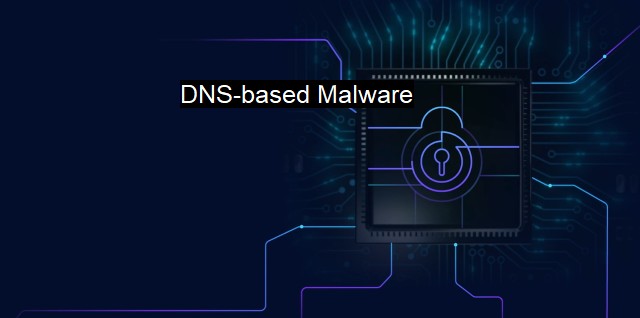What is DNS-based Malware?
Protecting Against DNS-based Malware Attacks: The Risks and Solutions
DNS-based Malware is a threat in the digital world, an alarming phenomenon that everyone who uses computing technology should be aware of. Whether you're a professional cybersecurity analyst, a website owner, or just an end-user browsing the internet, having a solid understanding of DNS-based malware can prevent future security breaches.To understand what DNS-based Malware is, we should first understand what DNS itself is. DNS stands for Domain Name System, a critical component of the internet infrastructure that translates human-friendly domain names into their corresponding IP addresses letting devices connect with each other. In other words, DNS functions like a phonebook for the internet, making connectivity quick and user-friendly.
DNS-based Malware, as the name suggests, is malicious software that exploits the DNS system to perpetrate illicit activities. It uses the DNS to deliver commands, steal information, or redirect users to fraudulent or malicious sites. Because DNS queries are necessary to navigate the internet and are generally trusted, they make an attractive spot for cybercriminals to hide their activities.
It pervades the computer systems in numerous ways. For instance, it might sneak into a user's machine disguised as a legitimate software program or through email attachments, USB drives, or illicit downloads. Cybersecurity professionals call these bait-and-switch tactics; they're like wolves in sheep's clothing. Thus, unwitting users download or install the infected software, subsequently introducing the malware into their systems.
Once active, DNS-based malware hits the DNS system. It may manipulate or change the settings of DNS to redirect users to harmful webpages when they attempt to access their banking website. Instead of opening the real website, the changed DNS sends the user to a fake site designed to look exactly like the original one. When the user enters their credentials, the information goes directly to the cybercriminal.
Not only this, DNS-based malware regularly uses "DNS Tunneling". This is one of the more insidious techniques where malware packages the data it wants to transmit out of your network inside of DNS questions and answers thus bypassing many traditional security tools. All this happens at the backend, making it hard for regular users to detect and deter these covert operations.
This insidious threat is indeed worrisome due to its nature that exploits DNS, something we rely on so intrinsically. They have the immense potential to cripple systems and steal precious or sensitive data. This ultimately raises the question, how do we protect ourselves against DNS-based malware?
Effective cybersecurity aligned with regular user training and awareness is critical. Users should be cautious while installing any software, inspect email attachments before downloading them, and only download content from verified and reliable sources. Beyond this, businesses and users alike should leverage advanced cybersecurity measures - firewalls, intrusion detection and prevention systems, DNS filtering, and endpoint security solutions.
It is also important to use a reputable antivirus program that can detect and neutralize malware. In particular, these programs perform regular system checks to ensure no unauthorized changes are made to your DNS settings. They are programmed to recognize common malware signatures and behaviors, alerting you when something is amiss.
DNS-based malware is a prevalent cyber-security threat. It manipulates one of the most basic and essential internet infrastructures to perform malicious tasks. Thus, staying informed about such threats, aware of our online activities, implementing robust security measures, and utilizing efficient antivirus software is fundamental in the face of such grave cyber vulnerabilities.

DNS-based Malware FAQs
What is DNS-based malware?
DNS-based malware is a form of malware that uses the Domain Name System (DNS) to carry out its malicious activities. Attackers can use various DNS techniques to redirect traffic to malicious servers or websites, enabling them to steal sensitive information or infect devices with malware.How does DNS-based malware spread and infect systems?
DNS-based malware can spread through various channels, including email attachments, malicious websites, and software downloads. Once it infects a system, it can modify the DNS settings to redirect internet traffic to malicious servers, allowing attackers to access sensitive information or install additional malware.What are some ways to prevent DNS-based malware attacks?
To prevent DNS-based malware attacks, you should ensure that all software and applications on your system are up-to-date, use reputable antivirus and malware detection software, and avoid clicking on suspicious links or downloading software from unknown sources. You should also configure your DNS server correctly and monitor network traffic for unusual activity.How can DNS-based malware attacks be detected and removed?
DNS-based malware attacks can be detected through various means, including monitoring network traffic for suspicious activities, analyzing DNS requests and responses, and using antivirus and malware detection software. Once detected, DNS-based malware attacks can be removed through various methods, including manually deleting the malicious files or using antivirus software to quarantine and remove the malware.| | A | | | B | | | C | | | D | | | E | | | F | | | G | | | H | | | I | | | J | | | K | | | L | | | M | |
| | N | | | O | | | P | | | Q | | | R | | | S | | | T | | | U | | | V | | | W | | | X | | | Y | | | Z | |
| | 1 | | | 2 | | | 3 | | | 4 | | | 7 | | | 8 | | |||||||